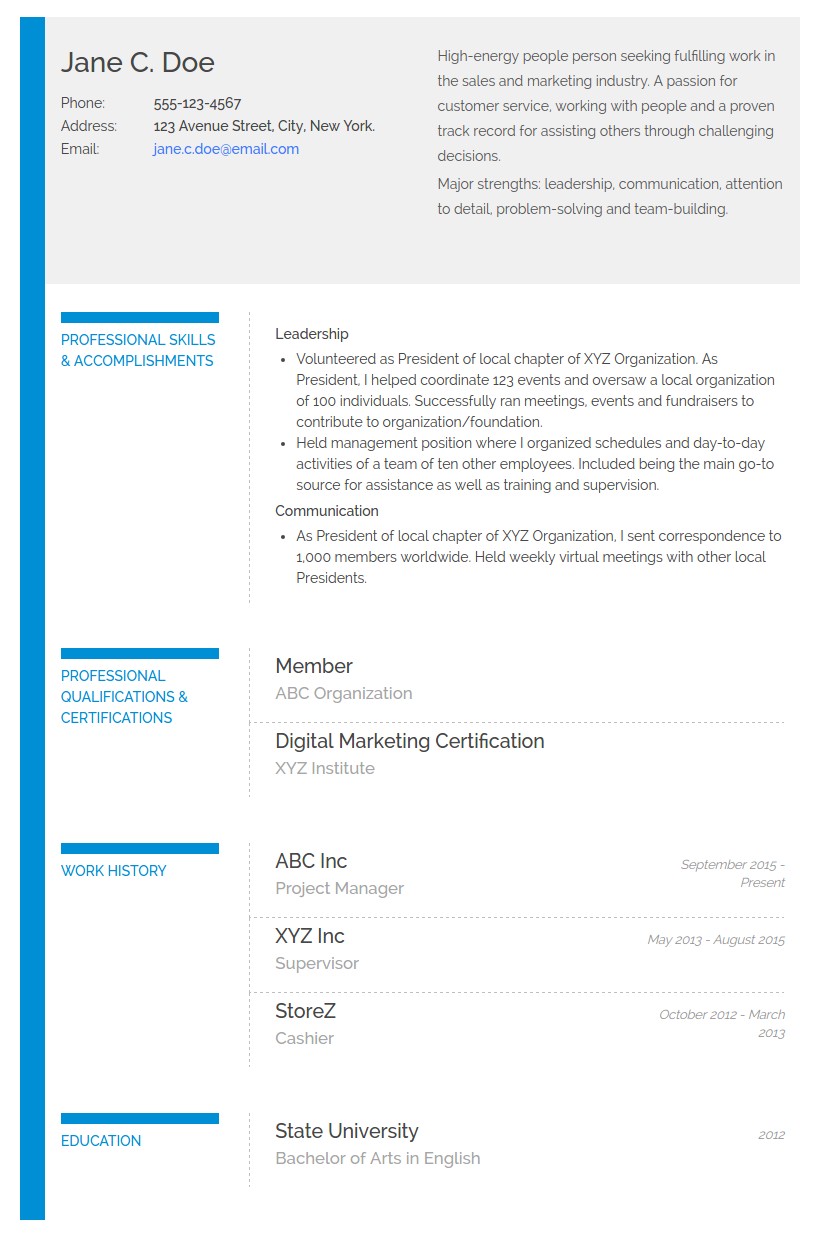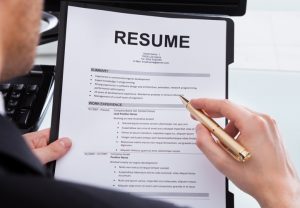
Whether you’re just entering the workforce or you’ve been working professionally for years, your resume is one of the most important documents for advancing your career. As the first introduction to your skills and personality, you want your resume to accurately reflect what you’re capable of.
Chances are, you’ve been told a resume should showcase your work history in a reverse chronological order. For someone who has followed a traditional path to advancing their career, this can be the best way to outline your accomplishments and relevant skills.
However, a reverse chronological resume isn’t right for everyone. Sometimes, a functional or skills-based resume just makes more sense.
But what exactly is a skills-based or functional resume and when should it be used? Let’s break down when you may want to consider using this type of resume.
What Is a Functional or Skills-Based Resume?
A functional resume, also referred to as a skills-based resume, outlines your skills and professional accomplishments rather than your work history. While you still include a brief overview of the places you’ve worked and your job titles, the main points of your resume centers on your skills — not your history of employment.
There are a few different circumstances where a functional resume makes more sense than a traditional reverse chronological resume. Let’s take a look at what a few of those may be.
When to Use a Functional or Skills-Based Resume?
Not everyone should use a functional or skills-based resume. Because it’s structured differently, it may not always be well-received when applying to a new job.
However, depending on your situation, the position you’re applying for and your previous work experience, a functional resume may do a better job at showing off your qualifications.
Here are some scenarios where you may want to use a functional or skills-based resume instead of a reverse chronological resume:
- You’re looking to change careers. If you’ve spent the majority of your working years in an industry that doesn’t relate to the one you’re trying to break into, you may feel like your experience is wasted. However, a functional resume allows you to focus on what you learned during that time and how it applies to the new industry, proving you’re qualified for the transition.
- You’ve worked mainly short-term or temporary positions. One thing hiring managers will look for is a solid work history. If you’ve spent most of your working years taking temporary contracts or you struggled to find the right “fit,” your resume may be peppered with short-term positions. A skills-based resume allows you to focus everything you’ve learned from these jobs and put it in a less overwhelming format.
- You’ve done a lot of volunteer work. Many people underestimate the skills they can develop from volunteer work — especially if you serve as part of a committee or planning team. If you’ve done extensive volunteer work, or held some kind of leadership position within the community, you’ve probably gained more than a few skills you’ll want to feature on your resume. A functional resume gives you the opportunity to do so.
- You took a long-term break from working. Large gaps in a resume can be a potential red flag with hiring managers. Whether you’ve decided to take time off to start a family, help with an aging family member or just to pursue your passion, you want to show that the time you spent out of the traditional workforce was not wasted. Creating a skills-based resume allows you to focus those developments.
- You’re new to the workforce. When you’re just about to start looking for your first real job, it can feel like you have no experience at all. However, when you’re just starting out, you sometimes need to get creative about the actual experience you have. Using a skills-based resume allows you to focus on things you’ve learned throughout school and how they relate to the position even if you don’t have any real-world experience.
A functional resume is great any time you feel like your work experience doesn’t accurately represent what you’re capable of achieving. If you feel like outlining your skills would give you an advantage when applying to a company, then consider creating a skills-based resume for your application.
How to Create a Skills-Based Resume
When creating a traditional reverse chronological resume, it’s pretty straightforward to structure your work listings. But when you’re creating a skills-based resume, you have a bit more room to get creative.
Here are some important steps to follow to ensure you’re creating a skills-based resume that accurately describes your capabilities:
- Select the right skills. Every time you decide to use a functional resume, you want to be sure the skills you feature directly apply to the job you’re applying for. Create a list of your skills and pick the right skills to feature, moving the most important ones to the top of the page.
- Create accomplishment statements. Just like a traditional resume, you’ll want to include practical examples of times those skills were used. Describe your accomplishments, the results and how you used your skills to make those results happen.
- Have a mission statement. A mission statement is incredibly important for a functional resume. Because it may not be immediately apparent why you’re applying to the job, you want to let the hiring manager know what you’re looking for. Including a mission statement in the resume summary at the top of the page can improve your chances of getting an interview.
- Don’t forget your work history. Even though a functional resume doesn’t focus on your work history, you still want to be sure to include it somewhere on the page. With a skills-based resume, a quick overview of your job titles, the position and the time you spent there is typically enough to help a hiring manager get an idea.
- Include your “extras.” On a functional resume, you’ll always want to include any awards, volunteer work, education, professional affiliations, certifications or articles you may have. Be sure to designate an area of your resume to any “extras” that show your qualifications, experience or capabilities.
Just like with a reverse chronological resume, feel free to get a bit creative about the way you lay out your details. However, you always want to put the most important information close to the top. Never assume the hiring manager will read the entire page of your resume, so be sure to put any information you want them to see as high up as possible.
Example of a Skills-Based Resume
Here is an example of a skills-based resume created using Resumonk’s Bold template:

Here is the text version of the above skills-based resume example:
—————————————–
Jane C. Doe
123 Avenue Street, City, NY, 11111
Phone: 555-123-4567
Email: [email protected]
Summary
High-energy people person seeking fulfilling work in the sales and marketing industry. A passion for customer service, working with people and a proven track record for assisting others through challenging decisions.
Major strengths: leadership, communication, attention to detail, problem-solving and team-building.
PROFESSIONAL SKILLS AND ACCOMPLISHMENTS
Leadership
- Volunteered as President of local chapter of XYZ Organization. As President, I helped coordinate 123 events and oversaw a local organization of 100 individuals. Successfully ran meetings, events and fundraisers to contribute to organization/foundation.
- Held management position where I organized schedules and day-to-day activities of a team of ten other employees. Included being the main go-to source for assistance as well as training and supervision.
Communication
- As President of local chapter of XYZ Organization, I sent correspondence to 1,000 members worldwide. Held weekly virtual meetings with other local Presidents.
PROFESSIONAL QUALIFICATIONS AND CERTIFICATIONS
- Member of ABC Professional Organization
- Recipient of the National Presidents Award
- Certified in ABC Professional Development for 2017
WORK HISTORY
- Project Manager, XXX Company, Fall 2015-Current
- Supervisor, YYY Company, Spring 2013-Fall 2015
- Cashier, ZZZ Store, Winter 2012-Spring 2013
EDUCATION
- Bachelor of Science, State University, 2012
—————————————–
Creating Your Functional Resume
Don’t be overly intimidated about creating your functional resume. While it may feel a bit unnatural to go against the traditional way of creating a resume, a functional resume can help prove you’re qualified for the position. With the right information, you can land a job you never thought possible.
Consider the most important information a hiring manager may want to see when they look at your resume. Even if you don’t have the direct work experience to show you have these qualifications, find some other skill or relevant accomplishment that can prove you know how to perform that style of task.
Remember — your functional resume should be tailored to the unique position you’re applying to. Be sure to switch it up, change up the skills, and adjust your accomplishment bullets to reflect what the company is looking for in the position they’re trying to fill. Tailoring your message to fit the needs of the position and the hiring manager can increase your chances of getting to the first interview.
If you don’t have the work qualifications to apply for a job you believe you’d be great at, don’t allow it to hold you back.
The Resumonk AI Resume Builder’s features, including AI Rewrites, AI Suggestions, and effortless imports from LinkedIn or PDF/DOCX files, are designed to help you create an impressive functional resume. Start your free trial today!



